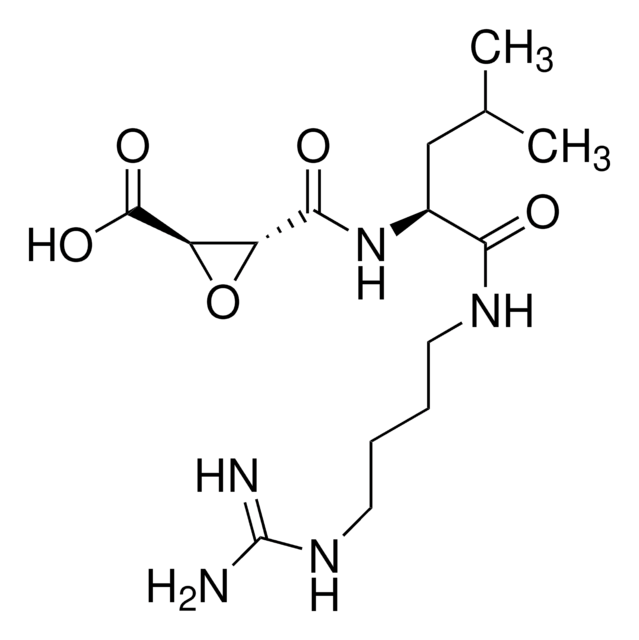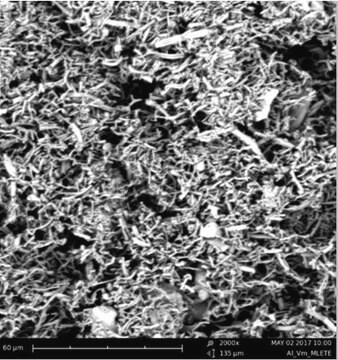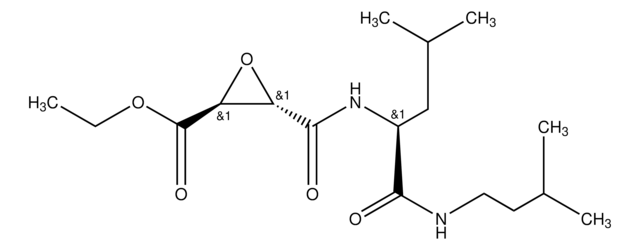E64-RO
Roche
E-64
N-[N-(L-3-Trans-carboxirane-2-carbonyl)-L-leucyl]-agmatine
Sinônimo(s):
E-64, n-[n-( l-transepoxysuccinic acid)-l-leucyl]-agmatine, n-[n-(l-3-trans-carboxirane-2-carbonyl)-l-leucyl]-4-aminobutylguanidine, n-[n-(l-3-trans-carboxirane-2-carbonyl)-l-leucyl]-agmatine.
note: another name for l-3-trans-carboxyoxiran-2-carboxylic acid acid is l-transepoxysuccinic acid. agmatine is 4-aminobutylguanidine., trans-Epoxysuccinyl-L-leucylamido(4-guanidino)butane, L-trans-3-Carboxyoxiran-2-carbonyl-L-leucylagmatine, N-(trans-Epoxysuccinyl)-L-leucine 4-guanidinobutylamide
About This Item
Produtos recomendados
Nível de qualidade
Ensaio
>95% (HPLC)
forma
powder
peso molecular
Mr 357.4
embalagem
pkg of 10 mg (10874523001)
pkg of 25 mg (11585681001)
fabricante/nome comercial
Roche
faixa de pH
2-10
solubilidade
ethanol: water (1:1): soluble 20 mg/mL
temperatura de armazenamento
2-8°C
cadeia de caracteres SMILES
CC(C)C[C@H](NC(=O)[C@@H]1O[C@H]1C(O)=O)C(=O)NCCCCNC(N)=N
InChI
1S/C15H27N5O5/c1-8(2)7-9(20-13(22)10-11(25-10)14(23)24)12(21)18-5-3-4-6-19-15(16)17/h8-11H,3-7H2,1-2H3,(H,18,21)(H,20,22)(H,23,24)(H4,16,17,19)/t9-,10+,11+/m0/s1
chave InChI
LTLYEAJONXGNFG-HBNTYKKESA-N
Procurando produtos similares? Visita Guia de comparação de produtos
Categorias relacionadas
Especificidade
Aplicação
It has been used in the affinity chromatography for the purification of hemoglobin receptors.
The inhibition of thiol proteases by E-64 appears to be of a non-competitive nature between the SH components. The inhibition is also irreversible, and is altered after gel filtration (Sephadex column) or dialysis after incubation of papain with E-64. The enzyme and inhibitor combine in an equimolar ratio.
Ações bioquímicas/fisiológicas
Nota de preparo
Working solution: Soluble to 20 mg/ml (stock solution) in a 1:1 (v/v) mixture of ethanol and water (vortexing or slight warming in water bath (40 °C) may facilitate dissolution). Also soluble in a neutral water/methanol solution, in water, methanol, acetic acid, pyridine and DMSO. Sparingly soluble in ethanol and propanol. Insoluble in acetone, chloroform, ethyl ether and benzene.
Storage conditions (working solution): -15 to -25 °C
Solutions are stable for one month when stored in aliquots at -15 to -25 °C.
Reconstituição
Outras notas
Palavra indicadora
Warning
Frases de perigo
Declarações de precaução
Classificações de perigo
STOT SE 2
Código de classe de armazenamento
11 - Combustible Solids
Classe de risco de água (WGK)
WGK 2
Ponto de fulgor (°F)
does not flash
Ponto de fulgor (°C)
does not flash
Certificados de análise (COA)
Busque Certificados de análise (COA) digitando o Número do Lote do produto. Os números de lote e remessa podem ser encontrados no rótulo de um produto após a palavra “Lot” ou “Batch”.
Já possui este produto?
Encontre a documentação dos produtos que você adquiriu recentemente na biblioteca de documentos.
Nossa equipe de cientistas tem experiência em todas as áreas de pesquisa, incluindo Life Sciences, ciência de materiais, síntese química, cromatografia, química analítica e muitas outras.
Entre em contato com a assistência técnica






